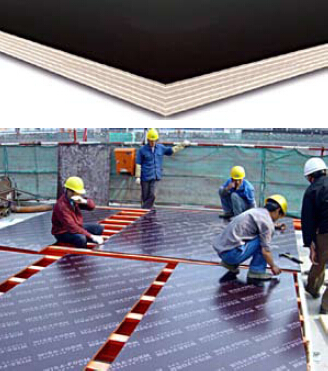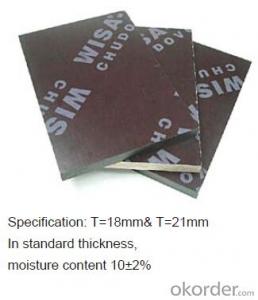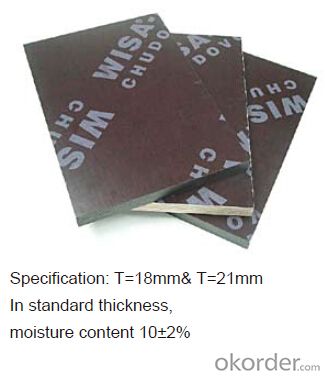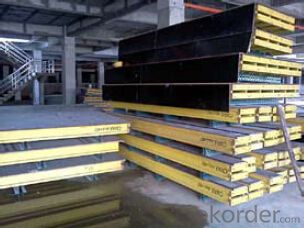Plywood Formwork system for Formwork and Scaffolding
- Loading Port:
- Tianjin
- Payment Terms:
- TT OR LC
- Min Order Qty:
- 50 g/m²
- Supply Capability:
- 1000 g/m²/month
OKorder Service Pledge
Quality Product, Order Online Tracking, Timely Delivery
OKorder Financial Service
Credit Rating, Credit Services, Credit Purchasing
You Might Also Like
Plywood --- make perfect concrete surface
WISA-Form Birch is a coated special plywood using in the formwork systems where high
requirements are set on the concrete surface and the times of reuses.
With CNBM timber beam & WISA plywood, the formwork is low weight but high load capacity, it is
widely used in construction.
Characteristics:
◆ Component with high standardization.
◆ Assembling in site, flexible application.
◆ Light weight, easy transportation and storage.


- Q: How does steel formwork contribute to the overall structural integrity of a building?
- Steel formwork contributes to the overall structural integrity of a building by providing a strong and rigid framework for pouring concrete. It ensures accurate alignment and dimensional stability, resulting in consistent and reliable construction. The use of steel formwork also enhances the load-bearing capacity of the structure, allowing it to withstand heavy loads and external forces. Additionally, steel formwork offers excellent durability and longevity, reducing the risk of structural failures over time.
- Q: Can steel formwork be used for both interior and exterior structures?
- Yes, steel formwork can be used for both interior and exterior structures. Steel formwork is versatile and can withstand various environmental conditions, making it suitable for both indoor and outdoor construction projects.
- Q: Can steel formwork be used for precast concrete facades with intricate patterns?
- Absolutely! Precast concrete facades with intricate patterns can indeed utilize steel formwork. Renowned for its robustness and longevity, steel formwork proves ideal for fashioning elaborate and meticulous designs. The adaptability of steel enables the crafting of intricate patterns, textures, and contours on the concrete surface. Moreover, steel formwork can be effortlessly tweaked and altered to accommodate any desired pattern or design, rendering it a favored option for precast concrete facades that demand intricate patterns or artistic elements. Ultimately, steel formwork offers the vital support and flexibility necessary to accomplish intricate designs in precast concrete facades.
- Q: Does steel formwork require special equipment for installation?
- Yes, steel formwork does require special equipment for installation. Unlike traditional wooden or plastic formwork, steel formwork is heavier and more rigid, requiring stronger and more specialized equipment to handle and install. The most common equipment used for steel formwork installation includes cranes, forklifts, and hoists to lift and position the steel panels and beams in place. Additionally, specialized tools such as clamps, braces, and connectors are needed to secure the formwork system and ensure it remains stable during the concrete pouring process. The use of special equipment not only facilitates the installation process but also ensures the safety and stability of the formwork structure.
- Q: Can steel formwork be used for underground culverts?
- Yes, steel formwork can be used for underground culverts. Steel formwork is durable and strong, making it suitable for withstanding the pressure and weight of the surrounding soil and water in underground culverts. It provides a stable and rigid structure that can be easily assembled and disassembled, allowing for efficient construction and maintenance of underground culverts.
- Q: How does steel formwork affect the overall thermal insulation of a building?
- Steel formwork does not directly impact the overall thermal insulation of a building. The purpose of steel formwork is to provide structural support during the construction process, allowing the concrete to be poured and shaped into the desired form. It is a temporary structure that is removed after the concrete has cured. Thermal insulation in a building is primarily determined by the materials used in the walls, roof, and floors, as well as the design and installation of insulation systems. These materials and systems are separate from the steel formwork used during construction. However, it is worth noting that the use of steel formwork may have an indirect effect on the thermal insulation of a building. The construction process itself, including the use of formwork, can impact the overall quality of the insulation installation. If not properly managed, the installation of insulation materials during or after the removal of steel formwork may be compromised, leading to gaps, voids, or poor installation that can affect thermal insulation. Therefore, it is essential to ensure that proper construction practices are followed, and insulation materials are correctly installed after the removal of steel formwork. This will help maintain the intended thermal insulation performance of the building.
- Q: Can steel formwork be used in areas with limited labor availability?
- Indeed, in areas where labor is scarce, steel formwork can prove to be an invaluable resource. Renowned for its versatility and durability, this system demands less manpower when compared to traditional formwork techniques. Its assembly and disassembly are effortless, and it can be utilized repeatedly, thus diminishing the necessity for constant labor in formwork construction. Moreover, steel formwork's lightweight nature enables easy transportation to remote regions, rendering it ideal for construction endeavors situated in areas where labor resources are limited. All in all, the employment of steel formwork facilitates an expedited construction process and optimizes labor utilization in regions with restricted labor availability.
- Q: What are the different types of bracing used with steel formwork?
- There are several types of bracing commonly used with steel formwork, including diagonal bracing, horizontal bracing, and vertical bracing. Diagonal bracing is used to provide stability and resistance against lateral forces, while horizontal bracing helps to control deflection and ensure the formwork remains in place. Vertical bracing is used to support the formwork system vertically and prevent any potential collapse. These different types of bracing work together to ensure the safety and stability of the steel formwork during construction.
- Q: How does steel formwork affect the overall construction productivity?
- Steel formwork revolutionizes the construction process by utilizing metal panels and supports to create temporary molds or frames for pouring concrete. This innovative technique offers numerous advantages over traditional timber formwork, including increased durability, reusability, and design flexibility. Consequently, steel formwork has a profound impact on construction productivity in multiple ways. To begin with, the utilization of steel formwork leads to heightened construction efficiency by reducing the time required for assembly and dismantling. Unlike timber formwork, steel panels are prefabricated and easily interconnected, allowing for swift installation and disassembly. This results in reduced labor hours and faster completion of formwork activities, ultimately accelerating the construction process. Moreover, the durability of steel formwork positively influences productivity. Steel panels have the ability to withstand harsh weather conditions, extreme temperatures, and heavy loads, ensuring their longevity and reusability. Consequently, contractors can reuse steel formwork on multiple projects, eliminating the need for frequent replacement and reducing material costs. The ability to reuse formwork not only saves time and money but also minimizes waste generation and promotes sustainability in the construction industry. Additionally, steel formwork offers greater flexibility in design, enabling the construction of complex structures with precision. The modular and adjustable nature of steel panels allows for easy customization according to project requirements, resulting in accurate and consistent concrete placements. This precision eliminates the need for excessive concrete rework, reducing material waste and saving construction time. The speed and accuracy provided by steel formwork positively impact overall construction productivity. Furthermore, steel formwork enhances safety on construction sites. Its sturdy structure and secure connections ensure stability during concrete pouring, minimizing the risk of accidents or structural failures. This increased safety reduces downtime caused by injuries or damages, ultimately improving productivity by maintaining a continuous workflow. In conclusion, steel formwork has a significant impact on overall construction productivity through various means. Its quick assembly and dismantling, durability, reusability, flexibility in design, and improved safety contribute to faster construction processes, reduced material waste, and enhanced efficiency. Embracing steel formwork techniques can lead to significant time and cost savings, ultimately benefiting the construction industry as a whole.
- Q: How does steel formwork affect the overall productivity of the construction process?
- Steel formwork can have a significant impact on the overall productivity of the construction process. Firstly, steel formwork is known for its durability and strength, allowing it to withstand the high pressures and forces exerted by concrete during the pouring and curing stages. This durability ensures that the formwork remains intact and stable, reducing the need for repairs or replacements, thus saving time and cost. Moreover, steel formwork offers increased efficiency in terms of assembly and disassembly. Steel panels can be easily connected and detached, allowing for quick and smooth installation and removal. This ease of use ensures that the construction process can progress at a faster pace, increasing overall productivity. Additionally, steel formwork provides a smooth and high-quality finish to concrete structures. The precise and rigid nature of steel formwork prevents any deformations or warping during the pouring and curing stages, resulting in a superior surface finish. This eliminates the need for additional finishing work, such as plastering or smoothing, thereby reducing the time and effort required for post-construction tasks. Furthermore, steel formwork is highly adaptable and can be customized to fit various shapes and sizes, enabling the construction of complex structures with ease. This flexibility allows for greater design freedom and eliminates the need for additional supporting structures, reducing construction time and increasing productivity. Lastly, steel formwork is reusable and can be used for multiple projects, unlike traditional timber formwork which often needs to be discarded after a single use. This reusability not only reduces material waste but also saves time and cost in procuring new formwork for each project. In conclusion, steel formwork significantly enhances the overall productivity of the construction process. Its durability, ease of assembly, high-quality finish, adaptability, and reusability all contribute to faster construction timelines, reduced costs, and improved efficiency, making it a preferred choice for many construction projects.
Send your message to us
Plywood Formwork system for Formwork and Scaffolding
- Loading Port:
- Tianjin
- Payment Terms:
- TT OR LC
- Min Order Qty:
- 50 g/m²
- Supply Capability:
- 1000 g/m²/month
OKorder Service Pledge
Quality Product, Order Online Tracking, Timely Delivery
OKorder Financial Service
Credit Rating, Credit Services, Credit Purchasing
Similar products
Hot products
Hot Searches
Related keywords

















